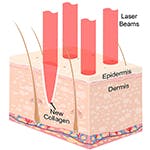Diode lasers have a unique combination of advantages: small size, modular architecture for simple power scaling, and unmatched electrical efficiency, and are now available at wavelengths in the blue, green, red, or near and mid infrared. This combination enables a diode laser system to be tailored to match the exact needs of a very wide range of medical applications, particularly in therapeutic procedures. Examples include blood photo-coagulation, hair removal, tightening collagen, tissue ablation in diverse surgeries, maximizing tissue ablation, killing dental pathogens, and so on.
Figure 1. In Fractional Resurfacing, a matrix of laser spots removes damaged tissue but leaves the intervening area intact to promote recovery. A diode laser at 1550 nm then tightens the underlying collagen.
Read this whitepaper to learn how diode lasers are configured and optimized to match several important therapeutic applications. In hair removal, for example, the laser wavelength is chosen to be strongly absorbed by the melanin pigment in hair but to minimize absorption in blood. And by optimizing pulse duration, the follicle cells are killed without causing thermal damage to the dermis. This pulse optimization is very simple to achieve with the fast on/off capabilities of diode lasers.
Skin tightening is another popular aesthetic procedure that works through the heating and consequent photocoagulation (tightening) of collagen using diode lasers at 1210 nm to minimize any absorption by melanin in the skin. Conversely, wrinkle removal and skin resurfacing depend on the laser light being absorbed by the dermis cells using 810 and 915 nm. And in a variant of skin resurfacing, a 1550 nm diode laser is used together with an infrared CO2 laser at 10.6 µm, in a procedure called “fractional resurfacing” - see Figure 1.
Learn how diode lasers are used in these aesthetic procedures, and other applications such as prostate surgery, photodynamic treatment of cancer, and new dental techniques.

